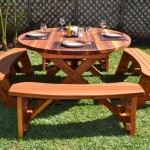Selecting the Correct Rug Size for a Round Dining Table
Choosing the appropriate rug size for a round dining table is crucial for both aesthetic appeal and functional comfort within a dining space. A well-proportioned rug anchors the table, defines the dining area, and contributes significantly to the overall ambiance of the room. Conversely, an incorrectly sized rug can disrupt the visual harmony, create tripping hazards, and diminish the dining experience. Therefore, a thoughtful approach to rug selection, considering table size, room dimensions, and desired aesthetic, is essential.
The primary objective is to ensure that all dining chairs remain comfortably on the rug even when pulled out from the table. This prevents chairs from snagging on the rug's edge or creating an uneven surface, which can be both uncomfortable and potentially damaging to flooring. Furthermore, the rug should extend far enough beyond the table to accommodate the movement of individuals seated at the table. The subsequent sections will outline the key considerations and guidelines for selecting the optimal rug size for a round dining table.
Determining the Minimum Rug Size
The foundation for selecting the correct rug size lies in accurately measuring both the diameter of the round dining table and the desired extension beyond the table's perimeter. As a general rule, the rug should extend at least 24 to 30 inches beyond the edge of the table to comfortably accommodate chairs. This extension provides sufficient space for chairs to be pulled out and pushed back in without slipping off the rug.
To calculate the minimum rug diameter, the following formula can be used: Table Diameter + (Chair Extension x 2). For example, if the dining table has a diameter of 48 inches (4 feet), and the desired chair extension is 24 inches (2 feet) on each side, the minimum rug diameter should be 96 inches (8 feet). This calculation ensures that the rug provides adequate coverage for chairs in use.
It is important to note that the 24-30 inch extension is a minimum guideline. In situations where chairs are particularly large or users prefer more space, a larger extension might be necessary. Similarly, if the room's overall dimensions allow, a larger rug can enhance the visual impact and create a more luxurious feel.
Considering Room Dimensions and Shape
While the table size and chair extension are critical factors, the overall dimensions and shape of the dining room also play a significant role in determining the appropriate rug size. The rug should be proportional to the room and avoid appearing either too small and isolated or too large and overwhelming.
In a smaller dining room, a rug that is too large can make the space feel cluttered and cramped. Conversely, a rug that is too small in a larger dining room can appear insignificant and fail to anchor the dining area properly. In a square or rectangular room, the rug should ideally be centered beneath the table and parallel to the walls. The rug should not extend too close to the walls, leaving a border of exposed flooring. A border of 18 to 24 inches is often recommended.
For open-concept dining areas, the rug serves as a visual demarcation, defining the dining space and separating it from adjacent living areas. In such cases, the rug size should be carefully considered to ensure it is proportionate to the overall open space and complements the surrounding furniture arrangements. It is also important to consider traffic flow when selecting a rug for an open-concept space; ensure the rug does not impede movement or create bottlenecks.
Evaluating Rug Shape and Material
Although the discussion centers on round dining tables, there are instances where a square or rectangular rug might be considered. While a round rug generally complements a round table more effectively, a square or rectangular rug can introduce a contrasting element and work well in certain design schemes, especially if the room's geometry is more angular.
If opting for a non-round rug, ensure its dimensions are sufficient to accommodate the chairs when pulled out, similar to the calculations for a round rug. The width and length of the rug should be carefully considered in relation to the table's position and the surrounding space. It's generally advisable to allow the distance between the edge of the table and the edge of the rug to be equal all around.
The material of the rug also influences its suitability for a dining area. Durable, stain-resistant materials like wool, synthetic fibers (such as polypropylene or nylon), or blends are recommended. Wool rugs are known for their durability, stain resistance (naturally occurring lanolin), and luxurious feel. Synthetic rugs are typically more affordable and easy to clean, making them a practical choice for high-traffic areas. Consider the rug's pile height as well. A low pile rug is generally easier to clean and allows chairs to move more smoothly. Very thick, shaggy rugs can be impractical under a dining table.
Color and pattern are also important considerations. The rug should complement the dining table, chairs, and overall décor of the room. Lighter colors can brighten a space and make it feel larger, while darker colors can add warmth and depth. Patterns can add visual interest and conceal stains, but they should not clash with other patterns in the room. Neutral rugs are a versatile choice that can blend seamlessly with various design styles.
Ultimately, selecting the correct rug size for a round dining table requires careful consideration of table size, chair extension, room dimensions, rug shape, and material. By following the guidelines outlined above, individuals can choose a rug that not only enhances the aesthetic appeal of their dining space but also provides a comfortable and functional dining experience.
Beyond the practical aspects of size and material, consider the texture of the rug. A subtly textured rug adds tactile interest without overwhelming the space. Avoid overly plush or high-pile rugs, as they can make chair movement difficult and trap food particles. Opt for a weave that is easy to clean and maintain, prioritizing functionality alongside aesthetics.
The budget is also a significant factor. Rug prices vary widely depending on material, size, and construction. Set a realistic budget before starting the search and prioritize quality within that framework. A well-chosen, durable rug is an investment that will enhance the dining space for years to come.
In conclusion, a well-chosen rug elevates the dining experience, providing comfort and style. The guidelines and considerations detailed above offer a comprehensive approach to navigating the selection process and ensuring a harmonious fit between rug, table, and dining space.

Rules Of Thumb For Rugs Under Round Dining Tables Inspiration

Your Guide To Outdoor Rug Sizes Authenteak

How To Choose The Best Dining Room Rug Size Color Caravan

Rules Of Thumb For Rugs Under Round Dining Tables Inspiration

N Handmade Natural Round Jute Rug Bedside Circle New Home Gift Boho Decor Patio Rustic Table

Standard Rug Sizes The Right Sized For Every Room Jessica Welling Interiors

How To Choose The Best Rug For Dining Table Povison Blogs

How To Choose The Best Dining Room Rug Size Color Caravan

Rules Of Thumb For Rugs Under Round Dining Tables Inspiration

The Ultimate Guide To Choosing Perfect Size Rug For Your Dining Ta Mh
Related Posts








